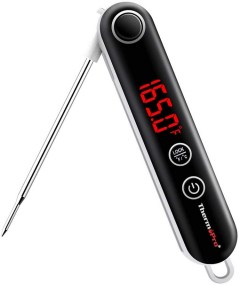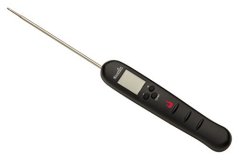Buying guide for Best meat thermometers
When it comes to your safety and your health, you should never just guess. Not cooking meat to the proper temperature puts you (and your loved ones) at risk for salmonella, listeria, E. coli, and other bacteria, infections, and parasites. A properly functioning meat thermometer is a great solution to be certain that your meat is safe to eat.
Instant-read analog thermometers are a good choice. However, if you are truly looking for the best, a wireless digital probe that you can leave in the meat as it cooks is great. This thermometer sends a signal to a handheld device so you can monitor the entire cooking process.
Meat thermometer types
Although it’s a simple tool, there are actually several different kinds of meat thermometers available for today’s cook.
Leave-in analog meat thermometers
These old-fashioned dial thermometers remain in the meat while it cooks. While inexpensive and easy to use, they’re also difficult to read without removing the meat from the oven — and sometimes they read higher than the actual meat temperature.
Instant-read analog meat thermometers
Inexpensive and readily available, these dial-top thermometers require a minute or less to provide a temperature reading once you insert the probe into the thickest part of the meat. It can be difficult to read the temperature, however, and you’ll get a false reading if you insert the thermometer incorrectly. Instant-read analog thermometers do not remain in the meat while it cooks.
Digital instant-read meat thermometers
Just push the probe into the thickest part of the meat, wait a few seconds, and read the temperature. Digital instant-read meat thermometers don’t stay inside the oven while the meat cooks.
"A leave-in digital probe thermometer has a very thin cord that connects the base unit to the thermometer. It is so thin that you can close your oven door on it without breaking the door’s seal."
STAFF
BestReviews
Thermometer forks
Shaped like a large, two-prong cooking fork, these thermometers are especially useful for outdoor grilling. They provide a nearly instant reading at the end of cooking time.
Leave-in digital probes
These thermometers provide the best of both worlds: the probe remains inside the meat as it cooks, while the base unit sits on the nearby counter where you can easily read it. A cord, which is thin enough not to break the oven door’s seal, connects the two. These are accurate, easy to use, and often have additional features such as timers and alarms.
Disposable pop-up indicators
You’ll most often use these in whole turkeys, and some meatpackers sell their turkeys with the pop-up indicator already in place. The indicator should pop up when the bird’s interior reaches the recommended temperature of 165°F, but they aren’t always reliable.
Leave-in wireless digital probes
These thermometers are similar to digital leave-in probes, but they transmit wirelessly to the base unit. That makes this type of thermometer a great choice for both outdoor grilling and indoor cooking.
We give bonus points to quality meat thermometers with a temperature alarm you can preset to ring when the meat reaches your desired temperature.
When researching meat thermometers, we look at all types, from digital to disposable to wireless.
We appreciate a meat thermometer with a backlight. This is especially useful if you’re using a grill or want to read the thermometer when it is deep in the oven.
We take note of meat thermometers that include a timer. If you need a reminder to check the progress of your meat, this feature comes in handy.
Readability matters to us. We understand that consumers appreciate a simple display that’s easy to read when they’re busy in the kitchen.
We often research meat thermometers that are preset to USDA-recommended safe cooking temperatures. This is a great feature for those who are new to cooking or nervous about eating undercooked meat.
We consider meat thermometers that can connect to Bluetooth or a smartphone. This feature allows you to check your meat remotely.
Water resistance is a valuable feature in a meat thermometer. When researching these products, we find out how well each item withstands splashes, cooking juices, and a good rinse in the sink.
We look at each meat thermometer’s temperature range. The best thermometers tend to have a top temperature of 400°F to 600°F.
Accuracy and speed are two top qualities we look for in the meat thermometers we research. A good thermometer should be able to read a temperature in 3 to 10 seconds.
Valuable meat thermometer features
Some meat thermometers do nothing more than indicate temperature; others have lots of bells and whistles. Every meat thermometer, whether simple or fancy, should provide accurate, easy-to-read results in a timely manner. If you prefer something beyond basic, however, here are some of the handiest features to look for.
- Temperature Alarm/Alert: A beep, flashing light, or combination of the two alerts you when the meat reaches the recommended or programmed temperature.
- Stabilization Alert: A beep lets you know that your instant-read thermometer has reached a stable temperature reading.
- Timer: Counts down your cooking time.
- Preset Temperatures: These thermometers are preset with the USDA recommendations for safe cooking temperatures.
-
Programmable Temperature: You can choose your own target temperature.
-
High-Temperature Alert: You’ll receive an audible alert or flashing light if the meat’s temperature goes above the programmed setting.
-
Dual Probes: One probe goes into the meat; the other monitors the temperature of your grill.
-
Rotating Display: The digital readout rotates to accommodate different angles. This is a useful feature if you cook a wide range of meats.
-
Temperature Range: The best meat thermometers have a wide temperature range. Some measure temps up to 600°F.
-
Backlight: It’s handy to have a backlight if you use your thermometer on the grill or want to be able to peer into the back of the oven.
-
Auto-Off: The thermometer shuts off when not in use to preserve battery life.
-
Water-Resistant or Waterproof: Your thermometer should be able to tolerate cooking juices, splashes of sauce, and occasional dunks in water for washing or calibrating.
-
Bluetooth-Compatible: Some wireless digital probes don’t even require a base; they connect right to your smartphone via Bluetooth.
-
Price: No need to break your budget on a meat thermometer. You can buy a good, albeit simple, digital thermometer for around $20. For a fancier model, expect to spend $50 or more.
"For ultimate control, choose a meat thermometer with a programmable target temperature feature."
STAFF
BestReviews
How to use a meat thermometer
The key to accurate results with a meat thermometer is in placing it in the meat correctly. No matter what type of meat you’re cooking, the thermometer should not touch bone. Generally, you want the tip of the probe in the thickest portion of the meat.
-
If you’re cooking a turkey or chicken, check the temperature in the bird’s thigh right near the breast. It’s easy to find the perfect spot by pushing the probe in until it hits the bone, then drawing the probe back a couple of inches.
-
For a large, boneless roast or ham, slide the thermometer’s probe into the thickest section of meat, avoiding any gristle or fat.
-
When checking hamburgers or thin cuts of meat, push the probe in sideways.
-
Once the probe is positioned correctly, leave it in place until you have your reading. Even an instant-read thermometer takes a few seconds to reach peak temperature.
-
Remember that meat continues to cook for up to 10 minutes after you remove it from the oven or grill, so adjust your cooking time if necessary.
Did you know?
Meat continues to cook for about 10 minutes after removal from the grill, stove, or oven. Take that into consideration for when to serve your dish.
STAFF
BestReviews
Calibrating your meat thermometer
An inaccurate thermometer isn’t useful, but how do you know if yours is accurate or not? The answer: you should calibrate your thermometer before its first use and then at least yearly — or anytime the thermometer is dropped or otherwise treated roughly.
-
Start by dipping the thermometer probe into a glass filled with ice and water. You should get a reading within a couple of degrees of 32°F.
-
Next, dunk your thermometer into a pot of boiling water. The reading should be within a degree or two of 212°F.
-
If your thermometer is out of calibration, follow the manufacturer’s guidelines for recalibrating it. If your thermometer does not allow recalibrations, it’s time to buy a new one.
Tips & caution
-
As you approach the meat’s internal center, your thermometer’s reading may dip down. This is normal. You want to make sure the coolest part of the meat is within the safe temperature range before you consume it.
-
A meat thermometer and a candy thermometer are two different things. If you want to use a meat thermometer to make candy, first make sure the temperature goes high enough for your candy recipe.
-
Just about every professional chef and top cooking website recommend digital meat thermometers over analog meat thermometers, as digital devices tend to be far more accurate.
-
For accurate (and safe) cooking results, don’t forget to calibrate your meat thermometer when you first buy it and at regular intervals after that.
-
Sanitization is very important when it comes to meat thermometers. Sanitize your meat thermometer before use, after use, and in-between uses if you’re switching the thermometer from one dish to another.
-
Salmonella is a foodborne illness that you can contract by eating undercooked meat. The CDC of the U.S. tells us that approximately 380 Americans die per year of salmonella poisoning.
-
Trichinella spiralis is a worm larva found in some undercooked game and pork. Ingesting this larva causes Trichinosis, an illness that involves gastrointestinal issues and other symptoms. The severity of Trichinosis may be affected by how much of the larvae are ingested.
-
Wash your thermometer’s probe by hand with gentle dishwashing soap and warm water after every use. Few are safe for the dishwasher.
-
If you’re cooking stuffing inside a turkey, both the turkey and the stuffing need to reach at least 165°F before they are safe to eat.




























































